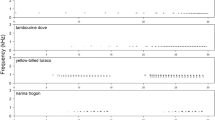Summary
We tested two predictions of the ranging hypothesis (Morton 1982) which suggests that: (1) For distance estimation of singing intruders from them, birds compare degraded songs they hear to undegraded songs in their memory. (2) The strength of response of birds to songs depends on how well they can range the songs as coming from inside or outside the territory.
In accordance with first prediction we found that, Carolina wrens discriminate significantly between songs played from outside to those played inside their territories only if they are familliar with the song type played (Fig. 1). In accordance with the second prediction, on the average, the birds in our study responded stronger to unfamiliar than to familiar songs when these were played from outside the territory, but stronger to familiar than to unfamiliar songs when played inside it (Fig. 2). We concluded that this was because they could range the familiar songs with greater certainty.
The variance in the data was, in part, due to changes in the birds' responses during the day. We report for the first time, an increase in the strength of territorial defense of birds later in the morning, accompanied by a decrease in singing in response to song playback. We suggest that these changes reflect an increase in energy gain and worse acoustic conditions later in the day.
Similar content being viewed by others
References
Becker PH (1982) The coding of species-specific characteristics in bird sounds. In: Kroodsma DE, Miller EH (eds) Acoustic communication in birds. vol 1, pp 214–244
Bjerke TK (1984) The response of male Redwings Turdus iliacus to playback of different dialects. Fauna [Norv Ser C] Cinclus 7:24–27
Borror DJ (1956) Variation in Carolina Wren songs. Auk 73:211–229
Brenowitz EA (1981) The effect of stimulus presentation sequence on the response of Red-winged Blackbrids in playback studies. Auk 98:355–360
Chu PR (1979) Geographic variation in song of island and mainland populations of the Carolina Wren. MS Thesis, University of Maryland, College Park
Dabelsteen T (1984) Variation in the response of freeliving Blackbirds Turdus merula to playback of song. II. effect of time of day, reproductive status and number of experiments. Z Tierpsychol 65:215–227
Falls JB (1982) Individual recognition by sound in birds. In: Kroodsma DE, Miller EH (eds) Acoustic communication in birds, vol 2, pp 237–278
Falls JB, Krebs JR, McGregor PK (1982) Song matching in the Great Tit (Parus major): the effect of similarity and familiarity. Anim Behav 30:997–1009
Gish SL, Morton ES (1981) Structural adaptations to local habitat acoustics in Carolina Wren songs. Z Tierpsychol 56:74–84
Goldman P (1973) Song recognition by Field Sparrows. Auk 90:106–113
Henwood K, Fabrick A (1979) A quantitative analysis of the dawn chorus: temporal selection for communicatory optimization. Am Nat 114:260–274
Kacelnik A, Krebs JR (1983) The dawn Chorus in the Great Tit (Parus major): proximate and ultimate causes. Behaviour 83:287–309
Krebs JR (1981) Song matching in the Great Tit Parus major L. Anim Behav 29:918–923
McGregor PK, Falls JB (1984) The response of Western Meadowlarks (Sturnella neglecta) to the playback of degraded and undegraded songs. Can J Zool 62:2125–2128
McGregor PK, Krebs JR (1984) Sound degradation a distance cue in Great Tit (Parus major) song. Behav Ecol Sociobiol 16:49–56
Morton ES (1975) Ecological sources of selection on avian sounds. Am Nat 108:17–34
Morton ES (1982) Grading, discreteness, redundancy and motivational-structural rules. In: Kroodsma DE, Miller EH (eds) Acoustic communication in birds. Academic Press, New York, London
Morton ES (1986) Predictions from the ranging hypothesis for the evolution of long distance signals in birds. Behaviour (in press)
Morton ES, Gish SL, Van der Voort M (1986) On the learning of degraded and undegraded songs in the Carolina Wren. Anim Behav 34:815–820
Petrinovich L, Patterson TL (1980) Field studies of habituation: III. Playback contingent on the response of the Whitecrowned Sparrow. Anim Behav 28:742–751
Richards DG (1981) Estimation of distance of singing conspecifics by the Carolina Wren. Auk 98:127–133
Simpson BS (1985) Effects of location in territory and distance from neighbours on the use of song repertoires by Carolina Wrens. Anim Behav 33:793–804
Weeden JS, Falls JB (1959) Differential response of male Ovenbrds to recorded songs of neighboring and more distant individuals. Auk 76:343–351
Wilhelm K, Comtesse H, Pflumm W (1982) Einfluss der Konzentration der Zuckerlösung auf den Gesang und das Balzverhalten des Gelbbauchnektarvogels (Nectarinia venusta). Z Tierpsychol 60:27–40
Ydenberg RC (1984) The conflict between feeding and territorial defence in the Great Tit. Behav Ecol Sociobiol 15:103–108
Author information
Authors and Affiliations
Rights and permissions
About this article
Cite this article
Shy, E., Morton, E.S. The role of distance, familiarity, and time of day in Carolina wrens responses to conspecific songs. Behav Ecol Sociobiol 19, 393–400 (1986). https://doi.org/10.1007/BF00300541
Received:
Accepted:
Issue Date:
DOI: https://doi.org/10.1007/BF00300541




